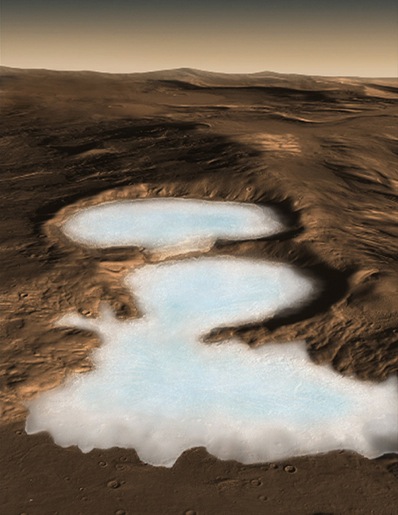NASA's Mars Reconnaissance Orbiter has revealed vast Martian glaciers of water ice buried under protective blankets of rocky debris at much lower latitudes than any ice previously identified on the Red Planet.
Using the spacecraft’s ground-penetrating radar instrument, which can see up to one kilometre below the surface of the planet, scientists have discovered that buried glaciers extend laterally for dozens of kilometres from the edges of mountains or cliffs in the Hellas Basin region of Mars' southern hemisphere.

Artist impression of an exposed glacier on Mars. Image: NASA/JPL.
"Altogether, these glaciers almost certainly represent the largest
reservoir of water ice on Mars that is not in the polar caps," says John Holt of the University of Texas at Austin, and lead author of the report that appears in the 21 November issue of the journal Science. "Just one of the features we examined is three times larger than the city of Los Angeles and up to half a mile thick. And there are many more. In addition to their scientific value, they could be a source of water to support future exploration of Mars."
Scientists have long been puzzled by the appearance of features known as ‘aprons’, gently sloping areas containing rocky deposits at the bases of taller geographical features, since NASA's Viking orbiters first observed them on the Martian surface in the 1970s. One theory has been that the aprons are flows of rocky debris lubricated by a small amount ice. The Mars Reconnaissance Orbiter has finally provided scientists with an answer to this long-lived mystery.
"These results are the smoking gun pointing to the presence of large amounts of water ice at these latitudes," says Ali Safaeinili, a shallow radar instruments team member with NASA's Jet Propulsion Laboratory. Radar waves are sensitive to changes in the electrical reflection characteristics of rock, sand or water. Water returns a particularly strong signal, and the latest measurements report that the radio waves pass straight through the aprons and reflect off a deeper surface below, without significant loss in strength. The readings imply that the aprons are composed of thick ice under a relatively thin covering of rock, and rule out the presence of a significant amount of rocky debris within the ice.

A large portion of a debris apron along the bottom of a hill on Mars. Scientists have long suspected that ice may be involved with ‘softening’ the appearance of these features, and radar has now revealed them to be hiding vast reservoirs of ice beneath a rocky surface. Image: NASA/JPL/University of Arizona.
It is now a priority to observe other examples of these aprons seen in different areas of Mars to determine whether they are also hiding ice. "There's an even larger volume of water ice in the northern deposits," says JPL geologist Jeffrey Plaut. "The fact these features are in the same latitude bands, about 35 to 60 degrees in both hemispheres, points to a climate-driven mechanism for explaining how they got there."
It is likely that the ice sheets were laid down during a previous ice age on Mars, and scientists suspect that the rocky debris blanket topping the glaciers has protected the ice from vapourising, which would happen if it were exposed to the atmosphere at these latitudes. The discovery is similar to massive ice glaciers that have been detected under rocky coverings in Antarctica.
"The tilt of Mars' spin axis sometimes gets much greater than it is now,” says James W Head of Brown University. “Climate modelling tells us ice sheets could cover mid-latitude regions of Mars during those high-tilt periods. The buried glaciers make sense as preserved fragments from an ice age millions of years ago.”
On Earth, buried glacial ice in Antarctica preserves the record of traces of ancient organisms and past climate history. Who knows what secrets the buried Martian glaciers are keeping.
from:astronomynow.com





 RSS Feed (xml)
RSS Feed (xml)